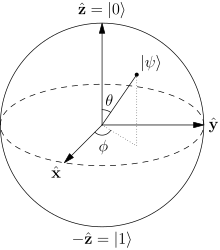Charge qubit
In quantum computing, a charge qubit (also known as Cooper-pair box) is a qubit whose basis states are charge states (e.g. states which represent the presence or absence of excess Cooper pairs in the island).[1][2][3] In superconducting quantum computing, a charge qubit[4] is formed by a tiny superconducting island (also known as a Cooper-pair box) coupled by a Josephson junction (or practically, superconducting tunnel junction) to a superconducting reservoir (see figure). The state of the qubit is determined by the number of Cooper pairs which have tunneled across the junction. In contrast with the charge state of an atomic or molecular ion, the charge states of such an "island" involve a macroscopic number of conduction electrons of the island. The quantum superposition of charge states can be achieved by tuning the gate voltage U that controls the chemical potential of the island. The charge qubit is typically read-out by electrostatically coupling the island to an extremely sensitive electrometer such as the radio-frequency single-electron transistor.

Typical T2 coherence times for a charge qubit are on the order of 1–2 μs.[5] Recent work has shown T2 times approaching 100 μs using a type of charge qubit known as a transmon inside a three-dimensional superconducting cavity.[6][7] Understanding the limits of T2 is an active area of research in the field of superconducting quantum computing.
Fabrication
Cooper-Pair Boxes are fabricated using techniques similar to those used for microelectronics. The devices are usually made on silicon or sapphire wafers using electron beam lithography (different from phase qubit, which uses photolithography) and metallic thin film evaporation processes. To create Josephson junctions, a technique known as shadow evaporation is normally used; this involves evaporating the source metal alternately at two angles through the lithography defined mask in the electron beam resist. This results in two overlapping layers of the superconducting metal, in between which a thin layer of insulator (normally aluminum oxide) is deposited.
Hamiltonian
If the Josephson Junction has a junction capacitance , and the gate capacitor , then the charging (Coulumb) energy of one Cooper-pair is:
If denotes the number of excess Cooper-pairs in the island (i.e. its net charge is ), then the Hamiltonian is[4]:
where is a control parameter known as effective offset charge ( is the gate voltage), and the Josephson energy of the tunneling junction.
At low temperature and low gate voltage, one can limit the analysis to only the lowest and states, and therefore obtain a two-level quantum system (a.k.a. qubit).
Note that some recent papers[8][9] adopt a different notation, and define the charging energy as that of one electron:
and then the corresponding Hamiltonian is:
Benefits
To-date, the realizations of qubits that have had the most success are ion traps and NMR, with Shor's algorithm even being implemented using NMR.[10] However, it is hard to see these two methods being scaled to the hundreds, thousands, or millions of qubits necessary to create a quantum computer. Solid-state representations of qubits are much more easily scalable, but they themselves have their own problem: decoherence. Superconductors, however, have the advantage of being more easily scaled, and they are more coherent than normal solid-state systems.[10]
Experimental Progress
Superconducting charge qubits have been progressing quickly. They were first suggested in 1997 by Shnirman,[11] and by 2001 coherent oscillations were observed.
References
- V. Bouchiat, D. Vion, P. Joyez, D. Esteve and M. H. Devoret, "Quantum coherence with a single Cooper pair", Physica Scripta T76, 165-170 (1998), doi:10.1238/Physica.Topical.076a00165
- Y. Nakamura, Yu. A. Pashkin and J. S. Tsai, "Coherent control of macroscopic quantum states in a single-Cooper-pair box", Nature 398, 786-788 (1999), doi:10.1038/19718, arXiv:9904003
- K. W. Lehnert, B. A. Turek, K. Bladh, L. F. Spietz, D. Gunnarsson, P. Delsing and R. J. Schoelkopf, "Measurement of the excited-state lifetime of a microelectronic circuit", Phys. Rev. Lett. 90, 027002 (2003), doi:10.1103/PhysRevLett.90.027002
- Makhlin, Yuriy; Schoen, Gerd; Shnirman, Alexander (2001-05-08). "Quantum state engineering with Josephson-junction devices". Reviews of Modern Physics. 73 (2): 357–400. arXiv:cond-mat/0011269. Bibcode:2001RvMP...73..357M. doi:10.1103/RevModPhys.73.357. ISSN 0034-6861.
- A.A. Houck et al., "Life after charge noise: recent results with transmon qubits," Quant. Inf. Proc. 8, 105 (2009), doi:10.1007/s11128-009-0100-6, arXiv:0812.1865
- H. Paik et al., "Observation of high coherence in Josephson junction qubits measured in a three-dimensional circuit QED architecture," Phys. Rev. Lett. 107, 240501 (2011), doi:10.1103/PhysRevLett.107.240501, arXiv:1105.4652
- C. Rigetti et al., "Superconducting qubit in waveguide cavity with coherence time approaching 0.1 ms," arXiv:1202.5533 (2012)
- Didier, Nicolas; Sete, Eyob A.; da Silva, Marcus P.; Rigetti, Chad (2018-02-23). "Analytical modeling of parametrically-modulated transmon qubits". Physical Review A. 97 (2): 022330. arXiv:1706.06566. Bibcode:2018PhRvA..97b2330D. doi:10.1103/PhysRevA.97.022330. ISSN 2469-9926.
- Schreier, J. A.; Houck, A. A.; Koch, Jens; Schuster, D. I.; Johnson, B. R.; Chow, J. M.; Gambetta, J. M.; Majer, J.; Frunzio, L.; Devoret, M. H.; Girvin, S. M. (2008-05-12). "Suppressing Charge Noise Decoherence in Superconducting Charge Qubits". Physical Review B. 77 (18): 180502. arXiv:0712.3581. Bibcode:2008PhRvB..77r0502S. doi:10.1103/PhysRevB.77.180502. ISSN 1098-0121.
- Superconducting Charge Qubits, by Denzil Anthony Rodrigues, page 3
- Shnirman, Alexander; Schön, Gerd; Hermon, Ziv (22 September 1997). "Quantum Manipulations of Small Josephson Junctions". Physical Review Letters. 79 (12): 2371–2374. arXiv:cond-mat/9706016. Bibcode:1997PhRvL..79.2371S. doi:10.1103/physrevlett.79.2371. ISSN 0031-9007.
